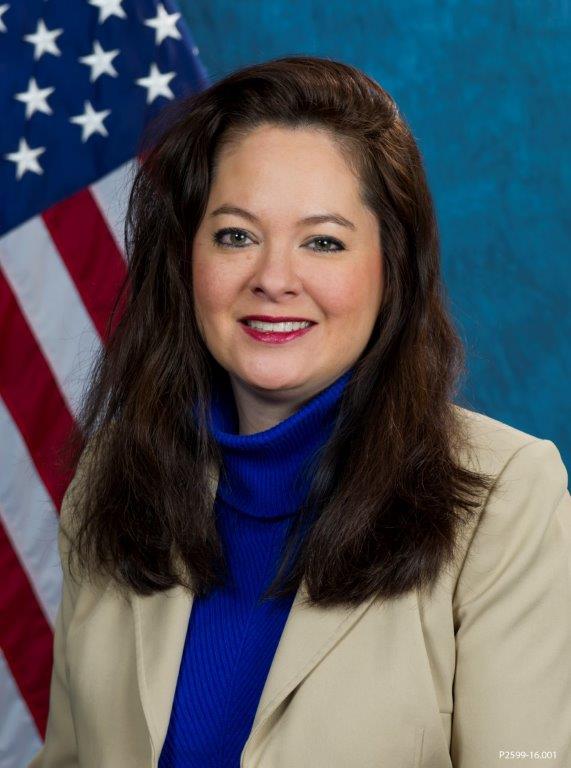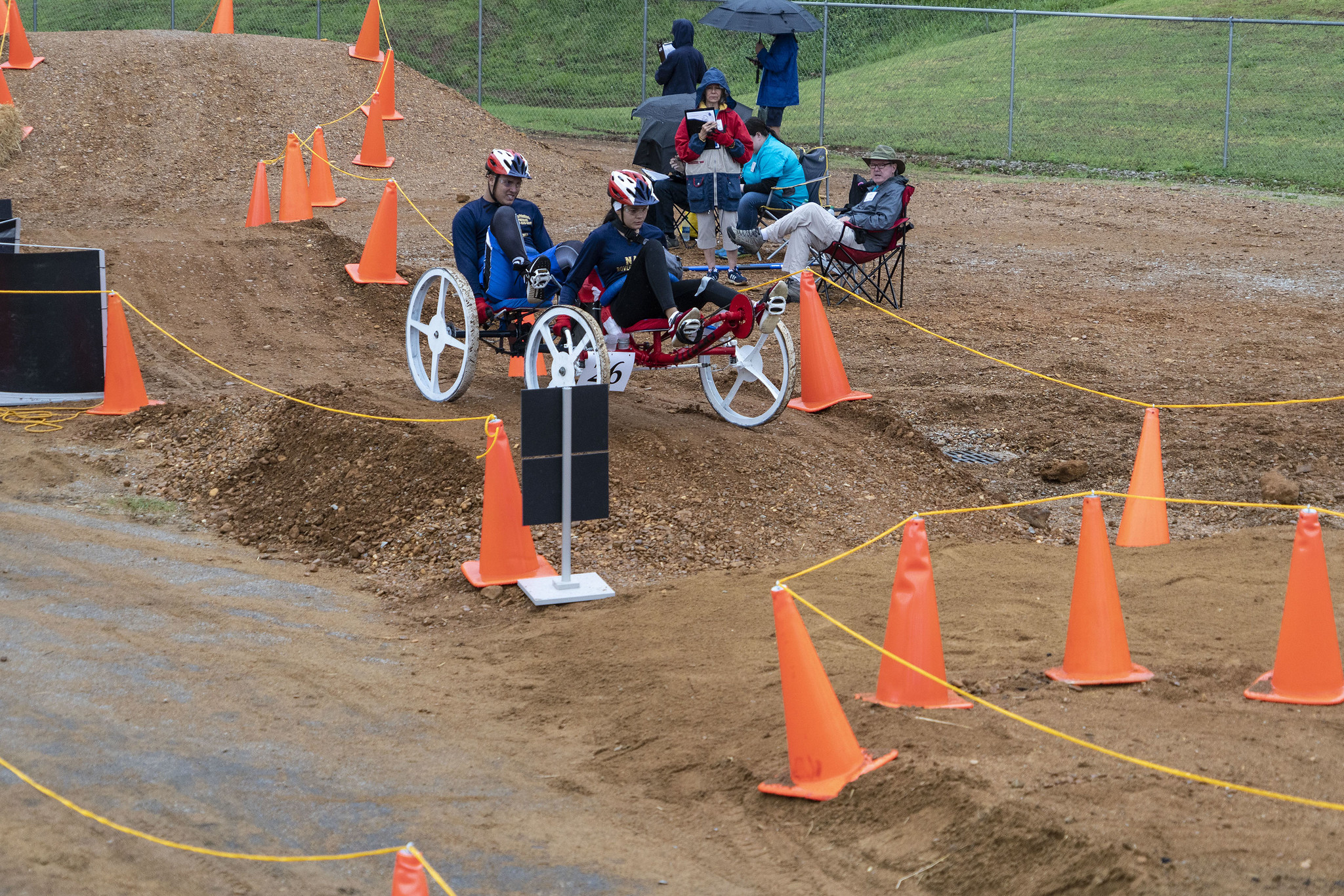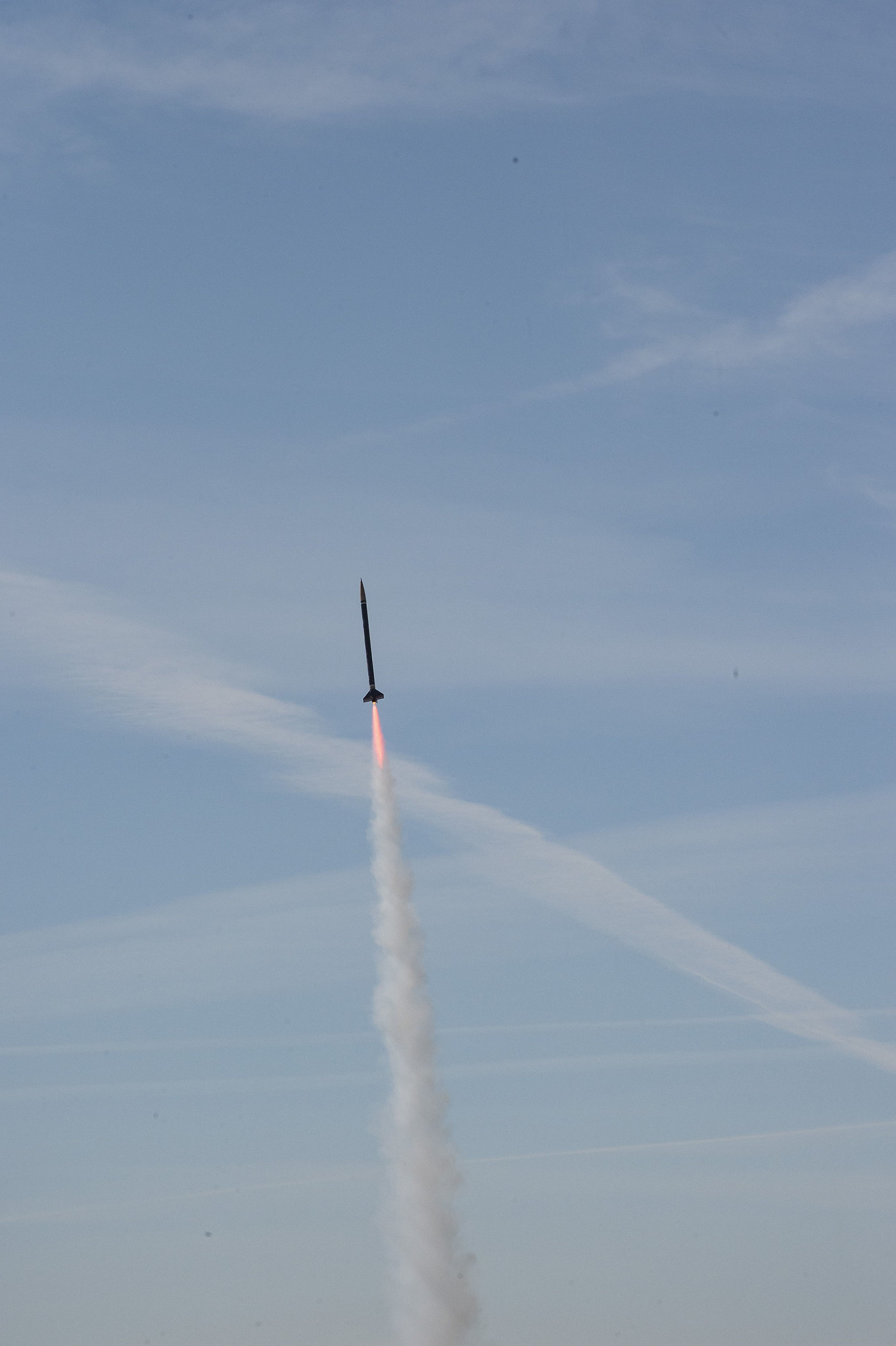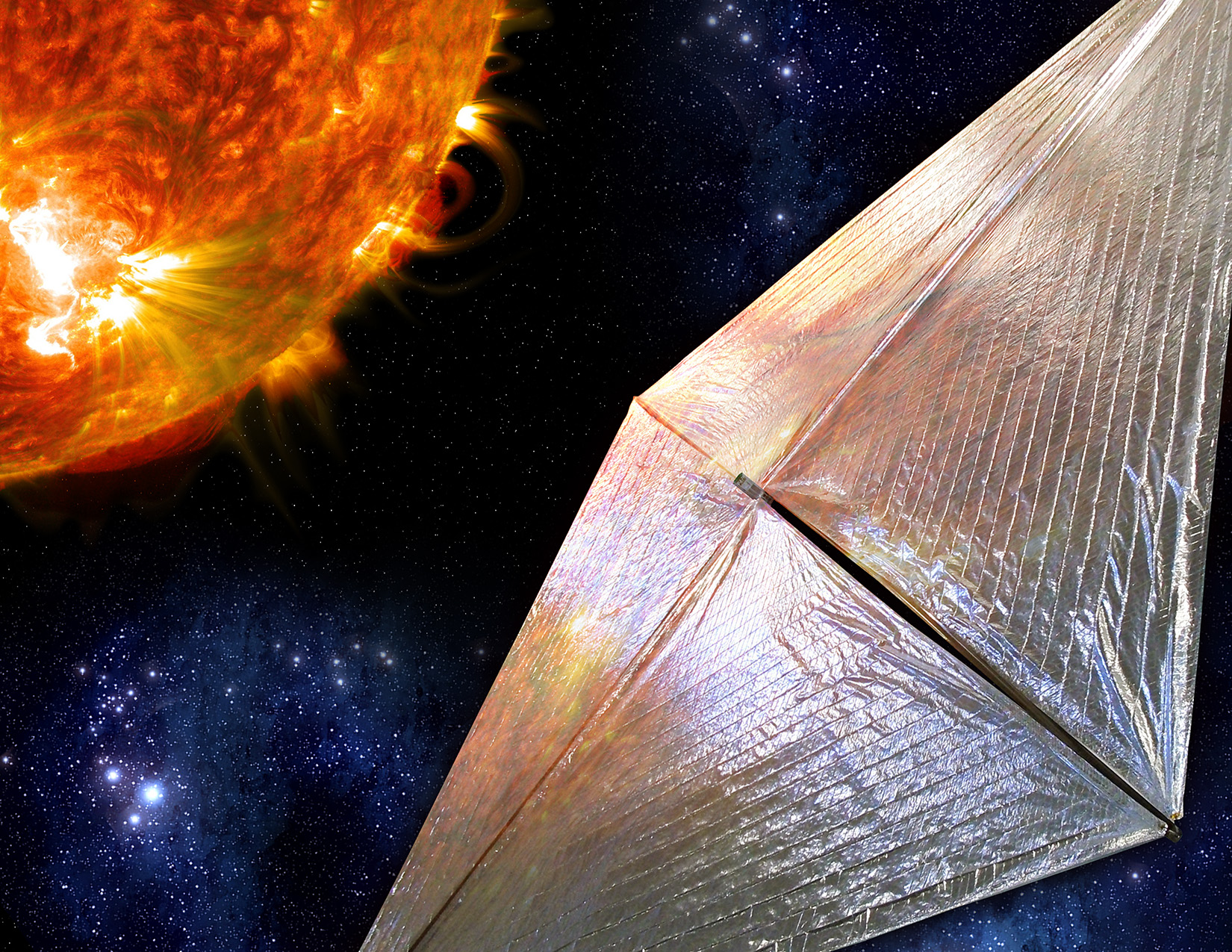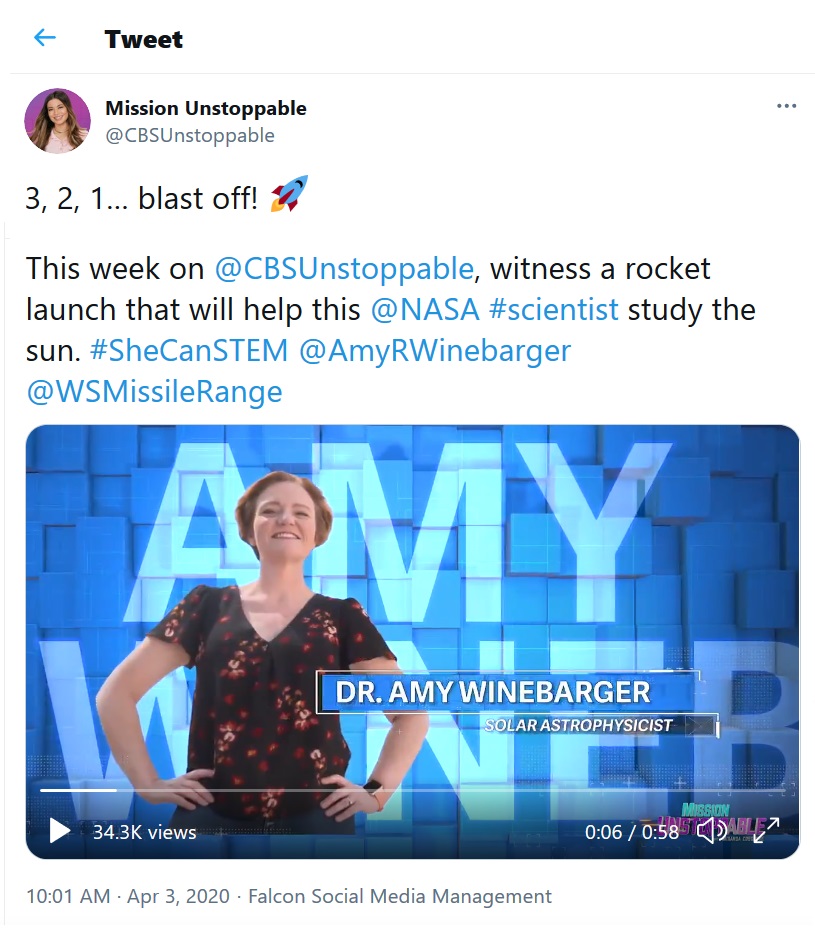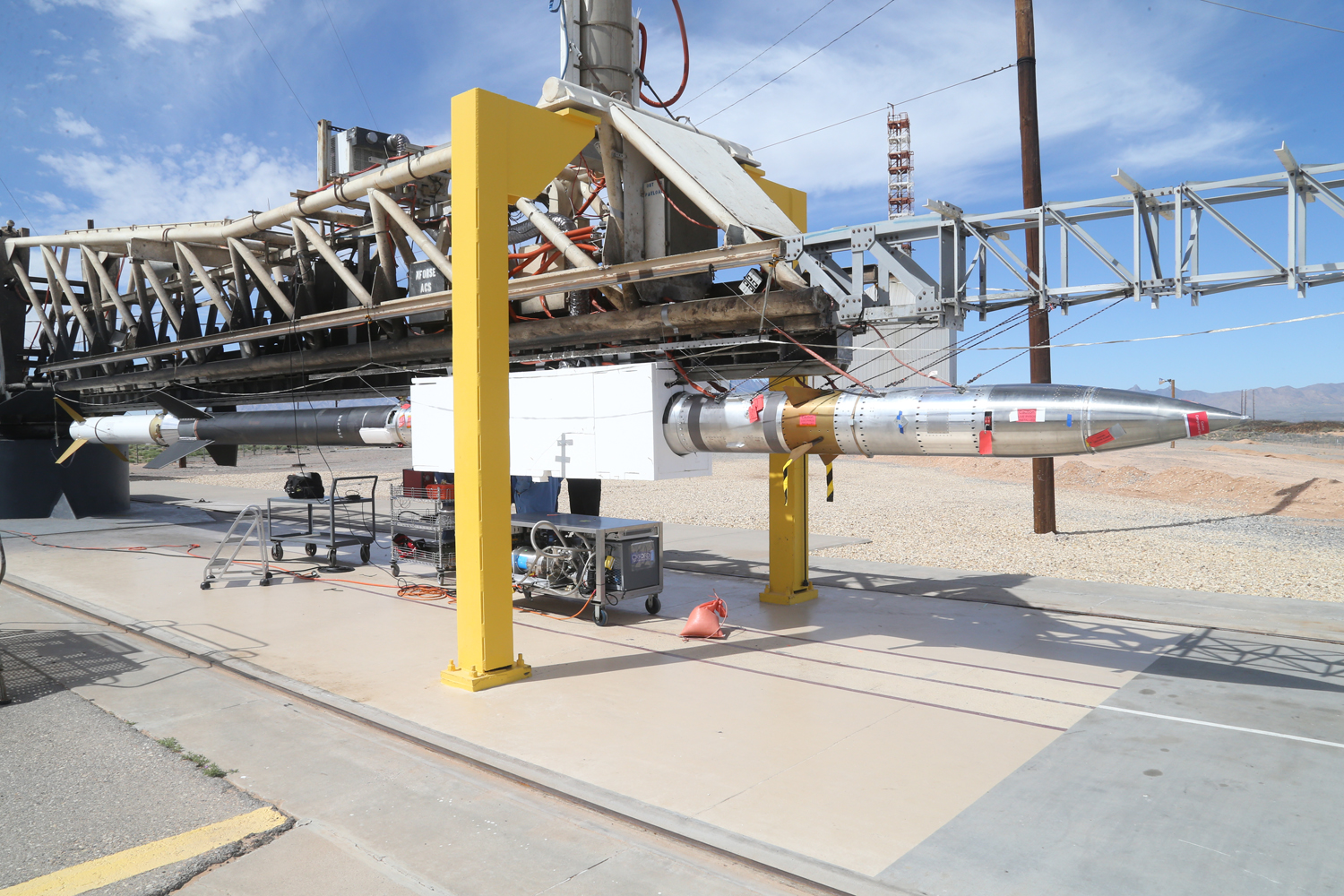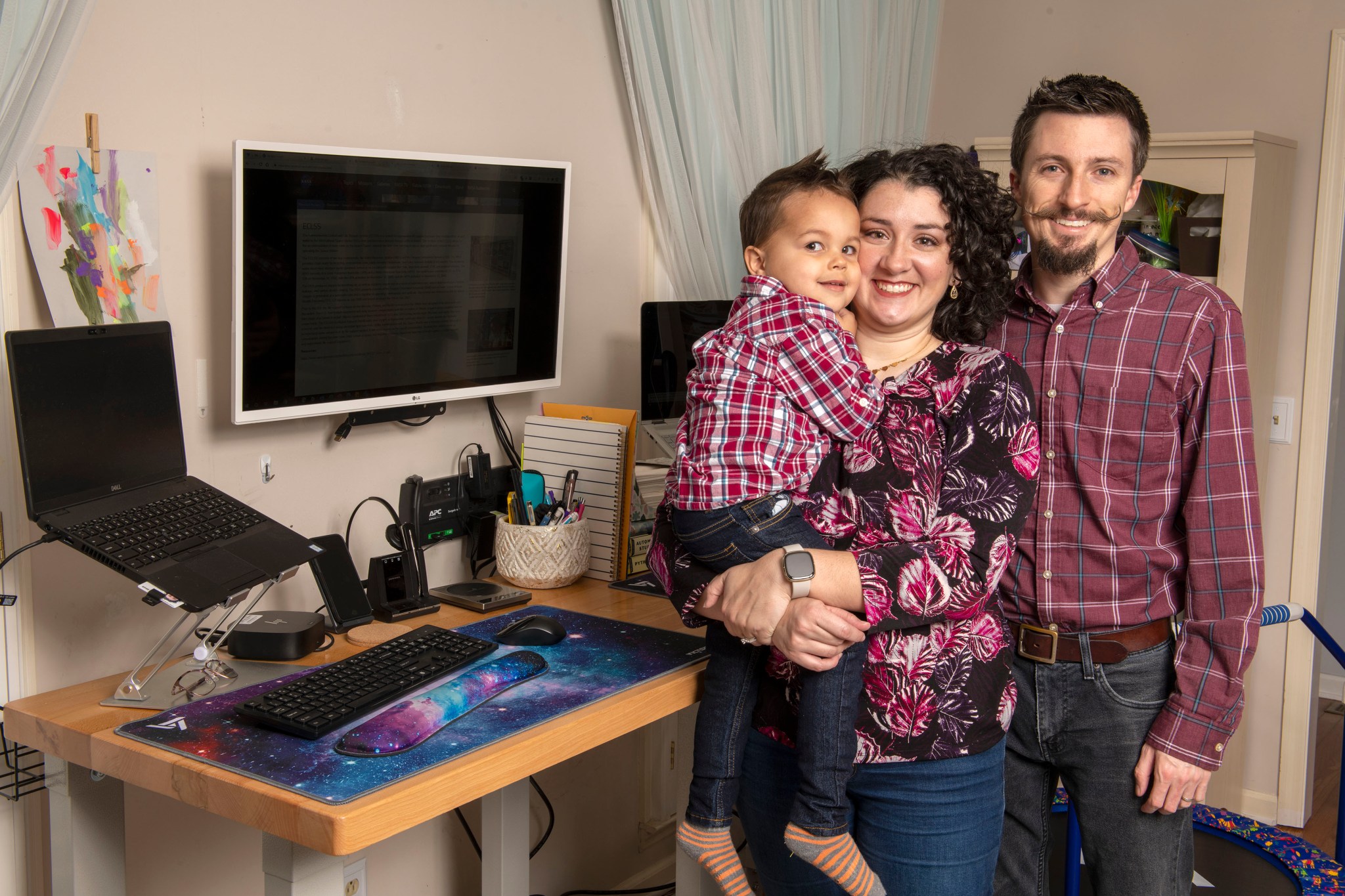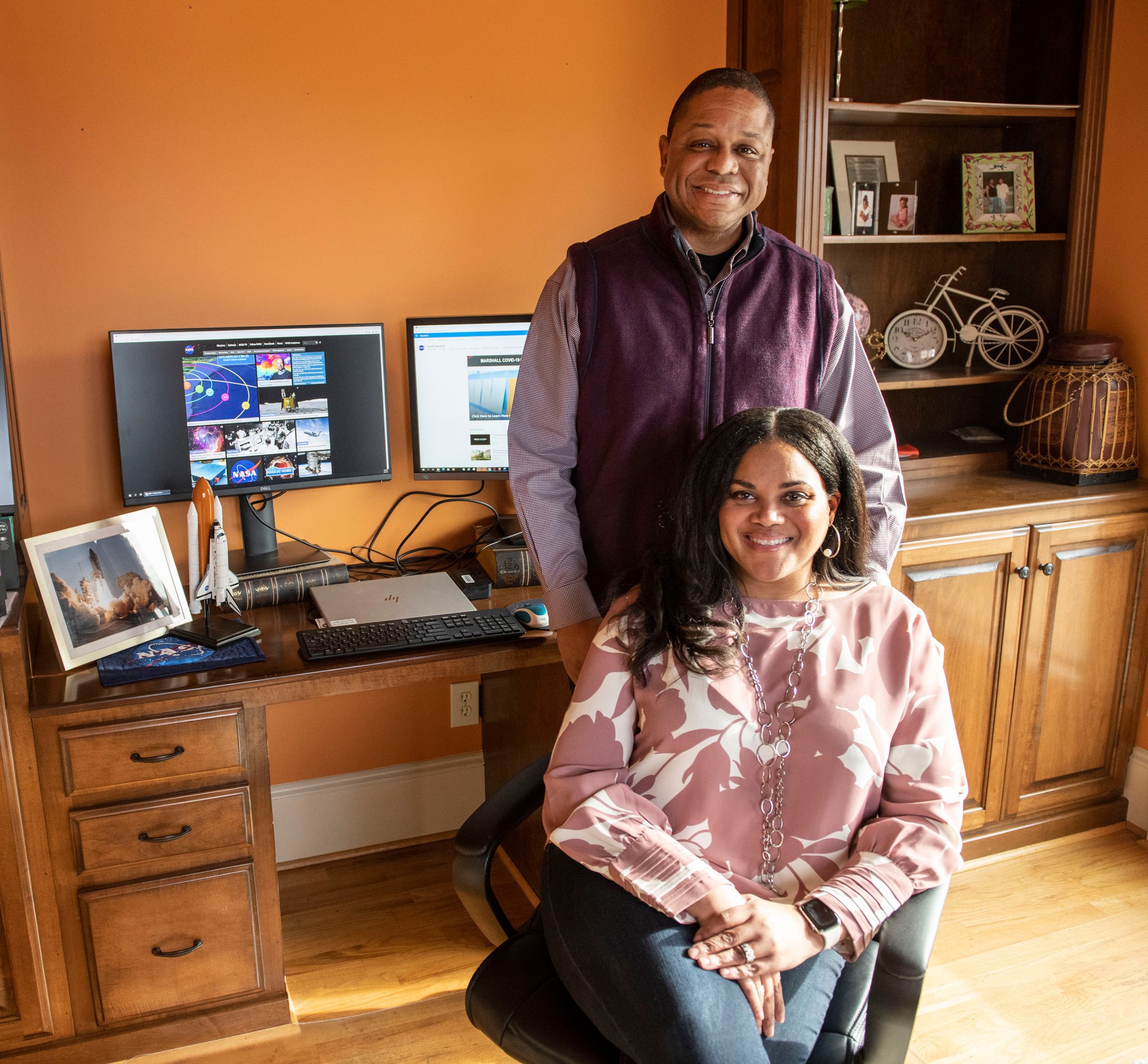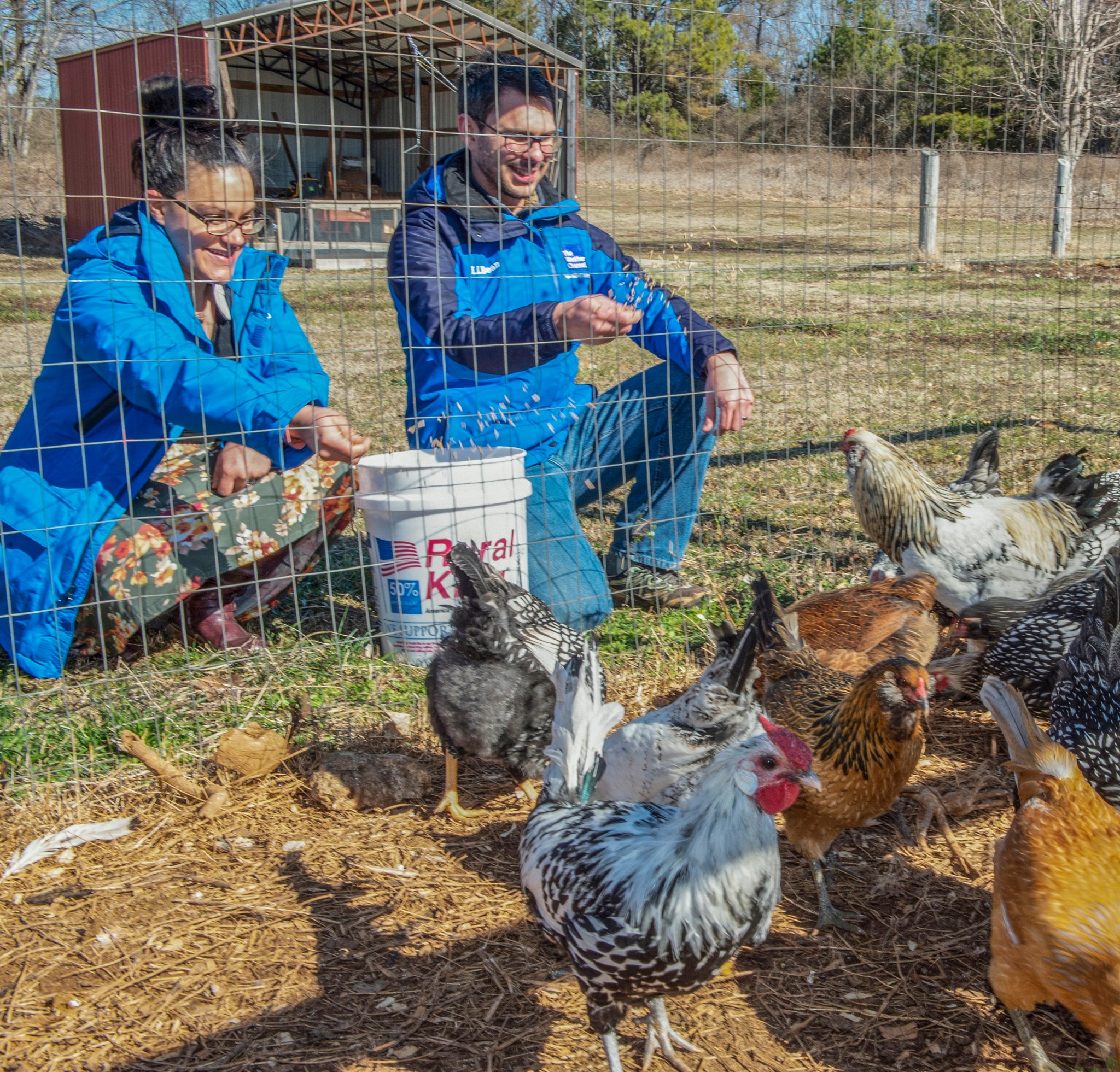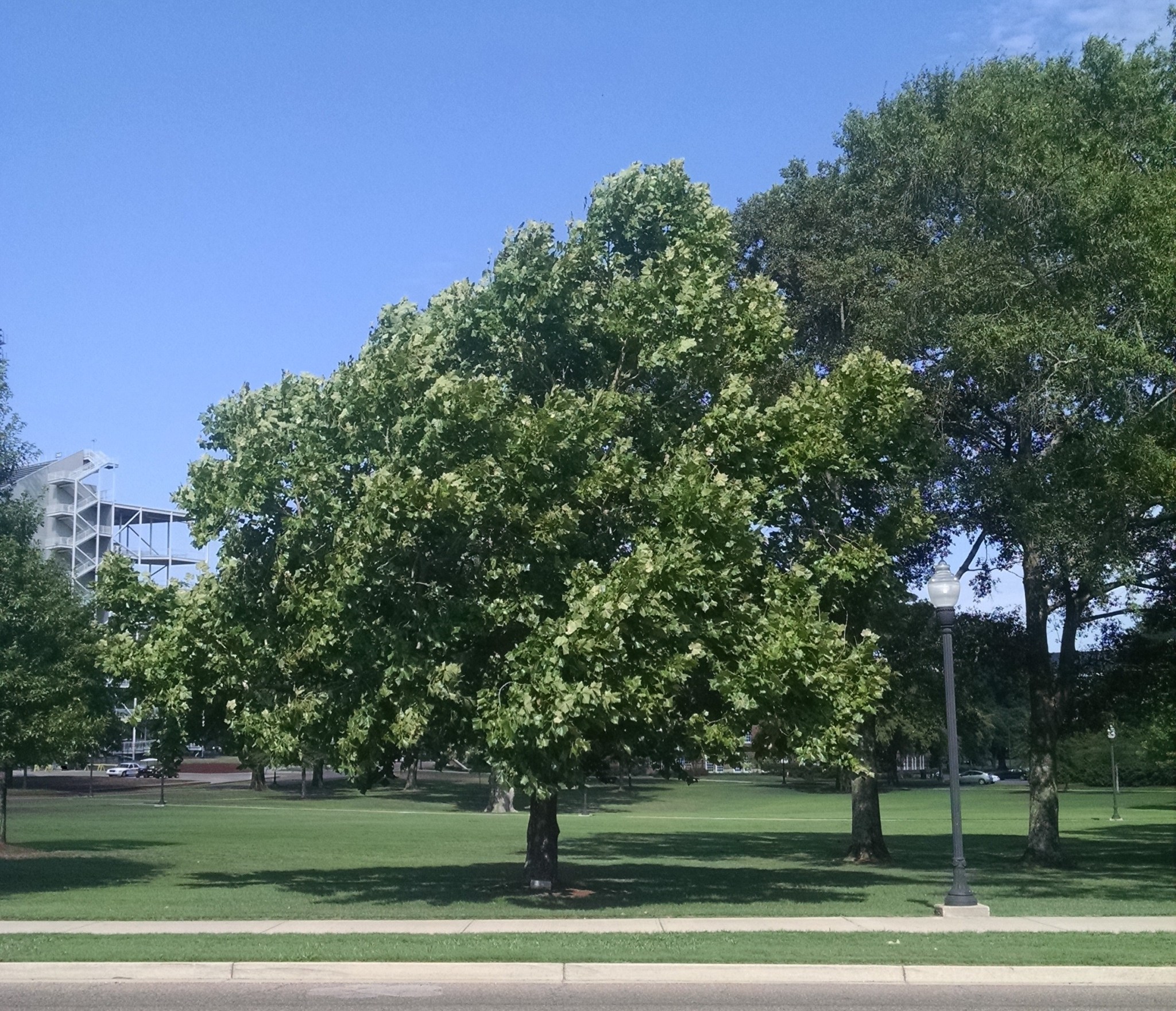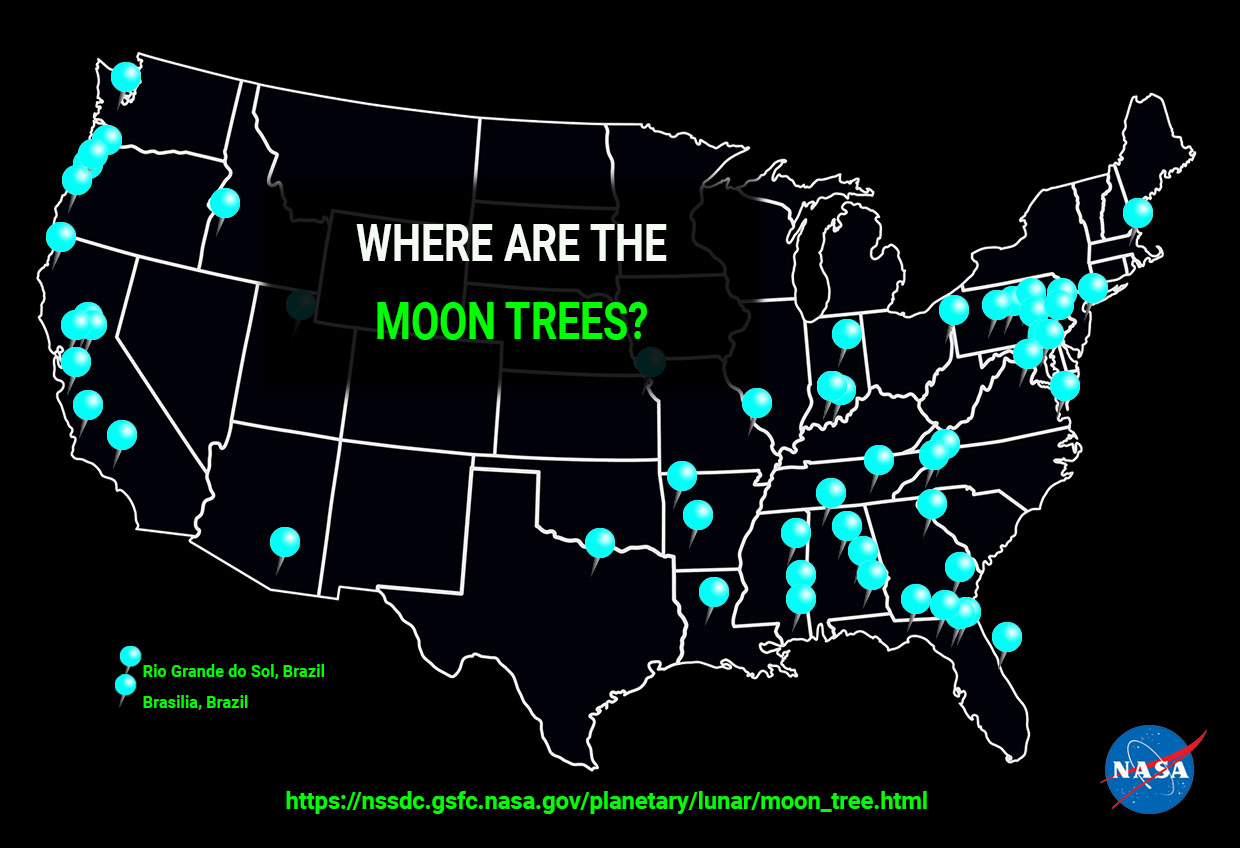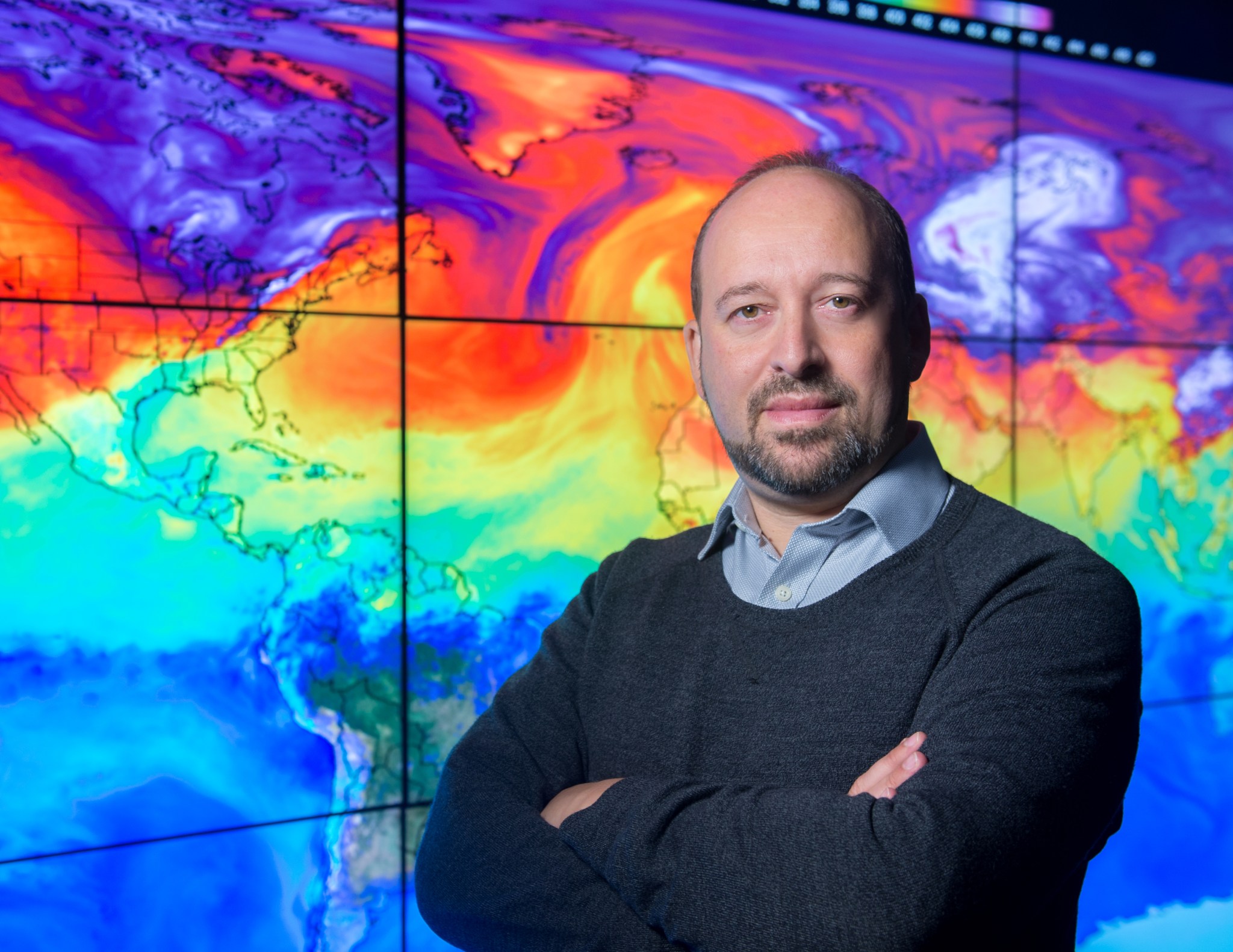In This Week’s Star
- Paula DeCesaris Appointed Deputy Director of Marshall’s Spacecraft and Vehicle Systems Department
- SLS Boosters for Artemis I Take Shape at Kennedy
- Human Exploration Rover Challenge, Student Launch Announce Modifications, Will Complete Competitions Virtually
- Nothing Like the Sun: Marshall Heliophysicists Study Earth’s Turbulent Star
- Love and Rockets: For Marshall Couples, Engineering a Strong Relationship Takes Communication, Chemistry, Hard Work – Just Like Their Day Jobs
- Moon Trees Stand as Living Testaments to First Voyages to Moon
- Chandra Spots ‘Furious’ Black Hole Growth in Wake of Galaxy Collisions
- NASA Announces Role of Senior Climate Advisor
- NASA’s Psyche Mission Reaches Milestone, Highlighted on ‘This Week @NASA’
- This Week in NASA History: STS-41B Lands – Feb. 11, 1984
Paula DeCesaris Appointed Deputy Director of Marshall’s Spacecraft and Vehicle Systems Department
Paula DeCesaris has been appointed to the Senior Executive Service position of deputy director of the Spacecraft and Vehicle Systems Department in the Engineering Directorate at NASA’s Marshall Space Flight Center, effective Feb. 14.
The Senior Executive Service is the personnel system covering most of the top managerial positions in federal agencies.
DeCesaris comes to Marshall from the Missile Defense Agency, where she was technical director for Test since 2015. DeCesaris was responsible for all technical aspects of planning, designing, and execution of the Ballistic Missile Defense System tests. She was also the agency’s cybersecurity testing lead, overseeing a diverse team to meet an increased testing pace, resulting in the successful execution of more than 340 exoatmospheric flight, ground, and cybersecurity tests. She also developed a long-term investment strategy for a responsive, risk-managed future test program.
DeCesaris began her federal service career in 1997 as an aerospace engineer at the Naval Surface Warfare Center in Dahlgren, Virginia. In 2001, she accepted a rotational assignment to the Test and Evaluation Directorate of the Ballistic Missile Defense Organization as the deputy program manager for the organization’s flight test airborne sensors assets. As the organization began limited defensive operations in 2005, DeCesaris became the Models and Simulations Accreditation agent and Independent Verification and Validation agent for the Ground Based Missile Defense program, and was later the Models and Simulations lead for the Missile Defense Agency Targets and Countermeasures program.
In 2007, DeCesaris officially joined the Missile Defense Agency as the Models and Simulations lead and division chief for the Ground Based Missile Defense Program. After later serving as a supervisor in the agency’s Ballistic Missile Defense System Models and Simulations Directorate, she became the director for System Assessment for the Missile Defense Agency Director of Engineering, where she was responsible for technical assessments of the Ballistic Missile Defense System as well as ground tests, cybersecurity, and digital Models and Simulations requirements and planning. As director of System Assessment from 2011 to 2015, she was responsible for planning, funding, and executing all Ballistic Missile Defense system-level assessments, including judging the system impact from the addition of every new Ballistic Missile Defense System Element software and hardware build and upgrade to the Operational Capacity Baseline as well as all Missile Defense Agency Technical Capability Declarations.
DeCesaris is an active participant in several professional forums, including the American Institute of Aeronautics and Astronautics, where she has authored and presented numerous papers. She has published various technical articles, papers, and reports in many additional national and international defense forums and has received multiple awards, including the Award for Excellence from the Office of the Secretary of Defense and the Navy Meritorious Civilian Service Award.
A Department of Defense Acquisition Corps member, DeCesaris is Level III certified in Engineering, Program Management, and Test and Evaluation and holds a bachelor’s degree in physics from Furman University in Greenville, South Carolina. She also has a master’s degree in aerospace engineering from Auburn University in Alabama and is a senior executive fellow with Harvard University’s John F. Kennedy School for Government in Cambridge, Massachusetts.
A native of Greer, South Carolina, DeCesaris lives in Huntsville with her husband, Chet, and her young daughter, Dori.
SLS Boosters for Artemis I Take Shape at Kennedy
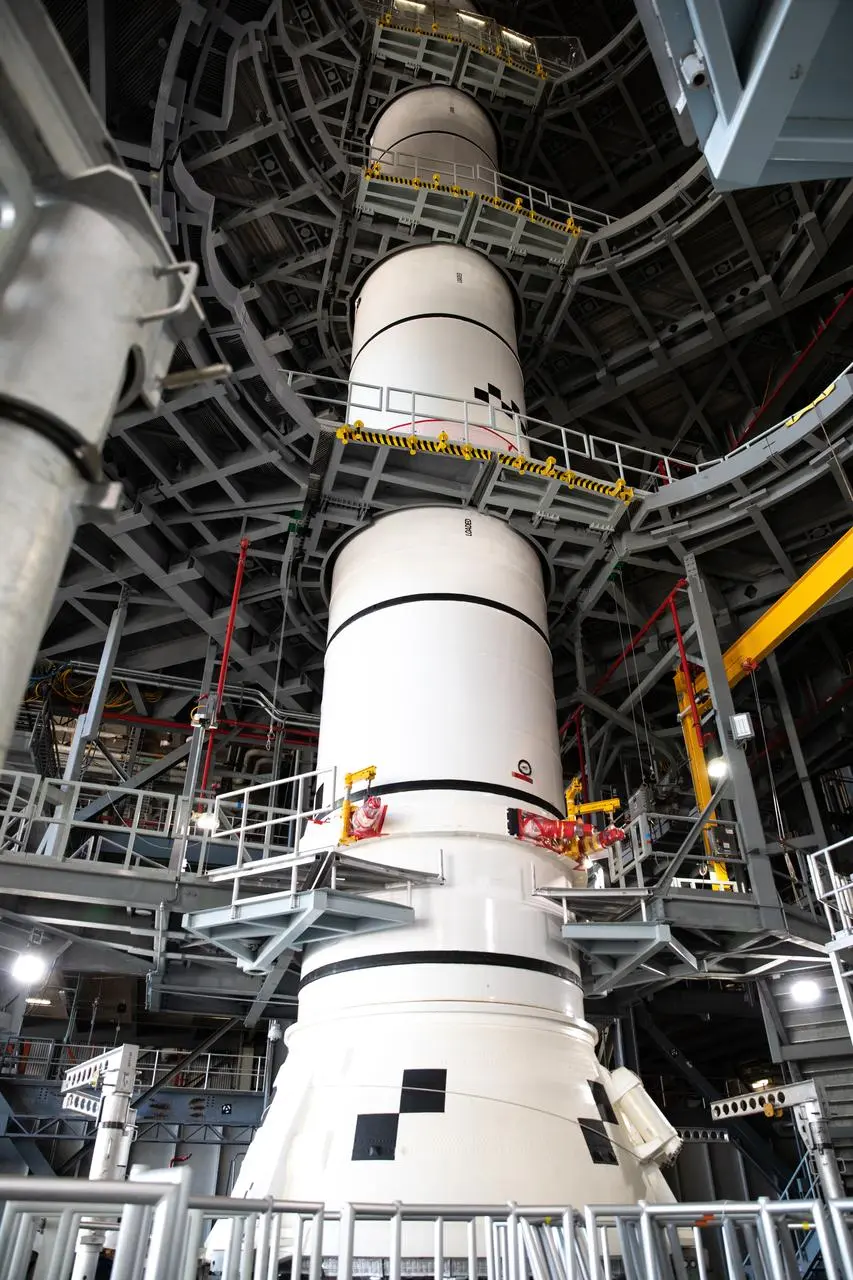
Teams stacked the second to last set of solid rocket booster segments for NASA’s Space Launch System rocket onto the mobile launcher inside the Vehicle Assembly Building at NASA’s Kennedy Space Center. The boosters will help power Artemis I, the first mission of NASA’s Artemis program. A crane was used to lower the right-hand forward center booster segment onto the center center booster segment on Feb. 4. Teams are stacking the twin five-segment solid rocket boosters on the mobile launcher over a number of weeks. To stack the boosters, engineers with NASA’s Exploration Ground Systems and Jacobs transport the segments from Kennedy’s Rotation, Processing and Surge Facility, where they have been since June. Once fully stacked, the SLS boosters will be 17 stories high. The boosters will provide more than 75% of the total thrust at launch. (NASA)
Human Exploration Rover Challenge, Student Launch Announce Modifications, Will Complete Competitions Virtually
NASA has announced that its Human Exploration Rover Challenge and Student Launch rocketry competition will be completed virtually, in alignment with organization safety and federal guidance to restrict the spread of COVID-19. The in-person events that are typically held in the spring will not take place.
The Human Exploration Rover Challenge awards will be presented virtually in a ceremony April 16 to reward the work that teams have and will complete.
For more than 25 years, the event and its sponsors have encouraged student teams from the United States and around the world to push the limits of innovation and imagine what it will take to explore the Moon, Mars, and other worlds. Although NASA will not be able to host teams in person this year, the students have gained significant value from the engineering, teamwork, and project tasks they have already completed.
Teams will be able to join the virtual awards ceremony as a group or from individual locations. Details will be distributed prior to the event. Awards will be given for Overall Winner, Project Review, Social Media, Rookie of the Year, Task Challenge, and STEM Engagement. Teams should reach out to event staff with any questions or for more details.
Student Launch typically culminates each April with a gathering of teams for a weekend of rocket launches and celebration. These events will be modified to take place locally to each team or virtually. A virtual awards ceremony will celebrate the teams this spring.
Student Launch challenges middle school, high school, college, and university students from around the United States to design, build, and test a high-powered amateur rocket, fly it at least 3,500 feet above the ground, and land. Teams compete in collegiate or middle/high school divisions, and are scored in nearly a dozen categories, including altitude, safety, vehicle design, social media presence, and science, technology, engineering, and mathematics engagement.
This year, Launch Division teams will complete the activity by launching at a local field, as outlined in the Student Launch Handbook. The Design Division competition will continue as outlined in the Student Launch Design Division Handbook Supplement. The project timeline and deliverable deadlines will remain unchanged for both divisions. Teams should contact Student Launch staff for questions or more details.
The Office of STEM Engagement at NASA’s Marshall Space Flight Center manages the Human Exploration Rover Challenge and Student Launch – two of NASA’s Artemis Student Challenges – to stimulate innovation and advance the agency’s mission through collaboration with educational institutions and students – the next-generation that will help explore the Moon and travel even farther to Mars.
Nothing Like the Sun: Marshall Heliophysicists Study Earth’s Turbulent Star
By Rick Smith
Editor’s note: This is Part 3 in a series showcasing science wins at NASA’s Marshall Space Flight Center in 2020 – and highlighting Marshall research across the unique science disciplines that drive NASA’s mission in 2021 and beyond.
Heliophysics encompasses study of the Sun and its effects on Earth, the solar system, and space itself. Living within the extended atmosphere of an active, sometimes turbulent star, NASA studies its origins and mechanisms to better predict its behavior, to protect Earth’s atmosphere and resources, and to unlock new discoveries about the larger, interlocking machinery of the physical universe.
“We often take the Sun for granted, but it has an undeniable impact on our solar system and on daily life on Earth,” said David Burns, manager of the Science and Technology Office at NASA’s Marshall Space Flight Center. “The tools of our modern lives – phones, internet and television, power grids, hospitals and emergency services, and more – depend on satellite-based connectivity and sensitive electronics like never before. These technologies can be disrupted or damaged by solar flares.”
Moreover, as humans venture farther away from Earth, and for longer periods of time, it’s the job of NASA solar scientists to assess how best to protect those explorers, their spacecraft, and their missions. For Marshall’s heliophysics division, that means developing new instruments to study the solar atmosphere and its energy output – and flying payloads, satellites, and sounding rockets that can withstand that fierce glare to gather vital new data and imagery.
In December 2020, NASA selected the Marshall-led Solar Cruiser, a SmallSat-deployed technology demonstrator mission, set to be launched in 2025 as part of the agency’s Solar Terrestrial Probes Program. Solar Cruiser, led by principal investigator and Marshall astrophysicist Les Johnson, consists of a nearly 18,000-square-foot solar sail. Once deployed, it will demonstrate the use of solar radiation as an in-space propulsion system – an innovation which could provide access to new orbital missions enabling high-value scientific discoveries.
Solar Cruiser will maintain an orbit along the Sun-Earth line slightly closer to the Sun than the so-called L1 point, where the gravitational forces of Earth and the Sun largely cancel out, creating a point of orbital equilibrium. By orbiting a solar monitoring spacecraft closer to the Sun, heliophysicists hope to obtain more advanced warnings of solar storms headed toward Earth.
“Our mission will demonstrate solar sail propulsion so that future missions using it can take heliophysics instruments to study the Sun from new destinations and novel vantage points not available to any other type of propulsion,” Johnson said.
In 2020, Marshall solar scientists continued work on numerous high-value projects to advance understanding of Earth’s parent star – including preparations for NASA’s ambitious Solar Flare Campaign investigation. In 2024, Marshall will launch its High-resolution and Coronal Imager, or Hi-C, sounding rocket in tandem with the University of Minnesota’s Focusing Optics X-ray Solar Imager, or FOXSI, from the Geophysical Institute’s site in Poker Flat, Alaska. Both imagers will be tasked with staring directly into the Sun during their suborbital flights – taking direct images of the star in the midst of solar flare activity to demonstrate the value of high-resolution, multi-spectral observations of such events.
As Hi-C and FOXSI fly, the Parker Solar Probe and Solar Orbiter – launched in 2018 and 2020, respectively – will be in prime viewing locations to observe the same event, giving researchers an even more comprehensive look at one of these high-intensity eruptions.
“We’ve documented flares in the past, when they happened to coincide with a sounding rocket launch or a mission flyby,” Marshall solar scientist Amy Winebarger said. “This is our first attempt to plan such a coordinated study. It’s going to be amazing.” The team will spend two weeks in Alaska, monitoring the solar surface for highly active pockets of magnetic fluctuation and staying ready to launch the moment a flare seems imminent.
Marshall researcher Sabrina Savage is principal investigator for Hi-C. FOXSI is led by principal investigator Lindsay Glesener of the University of Minnesota in Minneapolis. NASA astrophysicist Wayne Baumgartner is overseeing the effort at Marshall to build FOXSI’s mirrors.
Hinode, the joint Japanese and American mission to explore the Sun’s magnetic fields, celebrated 5,000 days in orbit in summer 2020. The mission, which launched in 2006 and for which Marshall led development of key NASA instruments, is part of the effort to learn more about the forces that power the Sun’s atmosphere and drive solar eruptions.
The heliophysics team also spent 2020 readying a sounding rocket instrument called the Marshall Grazing Incidence X-ray Spectrometer, for which Winebarger is principal investigator. Developed in partnership with the Smithsonian Astrophysical Observatory in Cambridge, Massachusetts, the instrument will obtain short-wavelength, soft X-rays of the solar atmosphere – using an original camera and optics developed and built at Marshall – to document coronal heating frequency. It is set to fly this August.
The Marshall solar team also continues to glean new findings from its successful Chromospheric Lyman-Alpha Spectro-Polarimeter, or CLASP, sounding rocket flights. Initially flown in 2015 to study the upper chromosphere’s magnetic field, CLASP got a second opportunity to fly in 2019, using ultraviolet light to unlock even more details about the chromosphere – and possibly begin deciphering how solar energy rises through the layers of the Sun’s atmosphere and shoots out into space.
Findings from CLASP-2, overseen by principal investigator David McKenzie, chief of Marshall’s Heliophysics & Planetary Science Branch, are expected to be published soon by Science Advances, the journal of the American Association for the Advancement of Science – but the team isn’t pausing for a victory lap. They’ve already proposed the next CLASP mission, designed to further document the chromosphere to deliver a one-of-a-kind 2D map of its magnetic field.
Because they’re smaller, more affordable, and faster to design and build than large-scale satellite missions, Winebarger is a firm believer in sounding rockets, which she said offer unique suborbital science opportunities, a chance to develop innovative new instrumentation, and rapid return on investment.
She insists there’s nothing quite like them – even amid the titanic rocket liftoffs so common to NASA and its global partners.
“To me, these launches are the best 10 minutes of your life,” she said.
Smith, a Manufacturing Technical Solutions employee, supports Marshall’s Office of Strategic Analysis & Communications.
Love and Rockets: For Marshall Couples, Engineering a Strong Relationship Takes Communication, Chemistry, Hard Work – Just Like Their Day Jobs
By Rick Smith
NASA’s mission is a marriage of science and exploration, a blend of hard-headed practicality and old-fashioned soaring romance. A belief in building something greater than oneself, and leaving the world a better place than it was before.
No surprise then, that NASA’s Marshall Space Flight Center is home to so many successful working couples – whose personal lives are built on the same shared drive and passion that fires their imaginations and fuels their careers.
With Valentine’s Day just over the horizon, Marshall takes pride in all those life partners who share their life’s work – or at least their workplace – and whose love for NASA’s science, engineering, human spaceflight, and institutional endeavors doesn’t just match their love for each other, but in many cases helped make it happen.
The Engineers: Jennifer and Matthew Pruitt
The former Jennifer DiBello was an undergraduate at Penn State University in State College, Pennsylvania, when she met Auburn University student Matthew Pruitt, a Huntsville native, at Marshall in 2008. Both were mechanical engineering students in NASA’s Cooperative Education Program. They bonded over lunches and weekend hikes, but it took the thunder of liftoff to ignite their love affair. The pair went to NASA’s Kennedy Space Center for the night launch of space shuttle Endeavor’s STS-123 mission in 2008, and that cinched it. They married in 2010.
Today, the Pruitts are full-time Marshall employees. Jennifer is a project manager in the Environmental Controls and Life Support Systems program in the Human Exploration Development & Operations Office. Her team maintains clean air and water resources for the International Space Station and develops advanced recycling and reclamation systems for future human missions to the Moon and Mars. Matthew is lead systems engineer for testing of NASA’s Near Earth Asteroid Scout robotic reconnaissance spacecraft. A secondary payload on Artemis I, the spacecraft will fly to a near-Earth asteroid to help NASA assess such cosmic travelers for potential resources – or potential threats to Earth or its satellites.
As NASA celebrates 20 years of continuous crewed operations on the space station, Jennifer said the Environmental Controls and Life Support Systems team is already looking ahead to what’s next. “It’s a great feeling to have helped maintain people’s existence in space for such a long time,” she said, “and now to pursue ways to expand that work for new missions and new destinations. Our eyes are always on the next challenge.”
The Pruitts have come to appreciate challenges. Sharing their home office over the past year, in keeping with NASA’s COVID-19 pandemic protocols, they’ve learned to negotiate their space, making room for each other as they go about their NASA tasks during the workday and savoring as much family time as possible with their 3-year-old son, Zeke.
“It’s important to be teammates, whether it’s at home as a team of two, or on the job amid dozens,” Jennifer said, “to rely on one another as workloads ebb and flow, and pick up the slack in a crisis, knowing you can rely on your partner to do the same when needed.”
Working in close proximity for the past year, she said, has enhanced both their skillsets. She’s picking up his test engineering tradecraft and lingo; he’s fine-tuning his problem-solving tactics thanks to her life support hardware engineering efforts.
It’s also created unanticipated moments of pride. “It’s a real thrill to see in action all those professional skills I knew Matthew had, but never witnessed up close because I was across campus doing my own job,” Jennifer said.
The IT Specialists: LaTonya and Brian Powell
For LaTonya and Brian Powell – both information technology managers in Marshall’s Office of the Chief Information Officer – the road to Marshall and to marriage was a stroke of chance rarer than a proverbial Blue Moon.
In the early 2000s, they were both consulting for the same global cybersecurity and digital technology firm – Oklahoma native Brian from offices in Dallas and lifelong North Carolinian LaTonya from her base of operations in Charlotte. Both were assigned to an IT project for a company in Lynchburg, Virginia – but only because Brian lobbied to stay and assist with other work after completing his assignment. Had he left as scheduled, they would have missed each other by mere days.
They became friends, then started seeing each other socially. But when a NASA contract job opened up, they said goodbye to long-distance dating and moved to Huntsville to pursue a three-year project overhauling Marshall’s enterprisewide financial applications. They married in 2002, and made the leap to full-time NASA employees in 2004.
Today, Brian is the acting deputy manager for IT authority in the applications division of Marshall’s Chief Information Office, where he oversees governance for enterprise software applications and associated technology platforms. LaTonya is supervisor of business-enabling applications for key institutional organizations across the center.
Working so closely together, they appreciate having a knowledgeable ear to bend at day’s end, and a partner to count on for insight or a fresh perspective. Even COVID-19 hasn’t altered their rhythm much – beyond where they sit to do their work. “We made the transition to full-time telework pretty seamlessly,” LaTonya said. “That’s the nature of IT.”
What’s their secret to making it all work? “Even when there are challenging days, when we don’t feel like we’re doing a great job keeping the balls in the air, we still make time to enjoy one another and the fruits of our shared labor,” she said.
“Find all the joy there is in life, every day,” Brian added. Part of theirs, he said, stems from working for the agency responsible for flying the space station, returning human explorers to the Moon, and furthering scientific knowledge. The Powells make every opportunity to share their excitement with their daughters Ava and Chloe, aged 13 and 10, respectively – from late-night jaunts to spot the passing space station, to active participation in their classrooms.
“Seeing our girls enthusiastic about math and science, thinking about them possibly following in our footsteps someday at NASA?” LaTonya said. “That’s incredibly rewarding.”
The Scientists: Erika and Patrick Duran
Marshall atmospheric scientist Patrick Duran and his wife Erika – a University of Alabama in Huntsville researcher supporting NASA’s Short-term Prediction Research and Transition Center – are hurricane scientists who try to live every day like they’re in the eye of the storm. No matter how much turbulence swirls about, they hold fast to the calm center of their lives.
Both were completing their doctoral work, she at the University of Washington in Seattle, he at State University of New York in Albany, when they met onstage at a science conference in 2015. Patrick presented first, noting connections between fluctuations in solar radiation and changes in hurricane structure – and Erika promptly followed him and stole his thunder, confidently outlining findings in an area he’d only begun to explore.
Naturally, it was kismet. They married in 2018, and began seeking world-class sites to pursue their research, paired with rustic country living ideal for raising a family – and chickens. “We were struck by the opportunities in Huntsville, the innovation of its government and academic research teams,” Patrick said. “But we also wanted the feel of a smaller town. We found that here.”
Erika joined the SPoRT team for UAH in early 2019, poring over remote sensing data to understand changes in storm intensity and structure. Patrick, who had joined Marshall as a post-doctoral researcher in the Earth science branch, followed her lead that fall, leading SPoRT tropical storm studies and developing novel hurricane forecasting techniques using NASA lightning data.
Their daughter, Josephine, was born in January 2021. Facing pregnancy in a pandemic may have caused the external storm to roil more vigorously, but the Durans embraced the experience, and said it strengthened their bonds. “We keep each other in balance,” Erika said. “And working from home was certainly easier, in many ways, than going to the office nine months pregnant!”
“It’s been amazing to have the support of the NASA team through this experience, from our arrival in Huntsville to Josie’s birth,” Patrick said. “We’re grateful to have employers and managers for whom family comes first.”
The work goes on – and it’s not just on Feb. 14 that these Marshall partners and so many others will take a moment to appreciate each other and all they share. “Life is about change, evolution, and growth,” Matthew Pruitt said, “but if the core of it, the essence, is built on love – whether for your career, your partner, or your family – you’ll be successful.”
Smith, a Manufacturing Technical Solutions employee, supports Marshall’s Office of Strategic Analysis & Communications.
Moon Trees Stand as Living Testaments to First Voyages to Moon
By Will Bryan
The craters, mountains, and plains of the Moon stretched beneath the Apollo 14 Command and Service Module Kitty Hawk in February 1971. While Commander Alan Shepard and Lunar Module Pilot Edgar Mitchell explored the Fra Mauro region of Earth’s celestial neighbor, Command Module Pilot Stuart Roosa conducted observations, experiments, and scientific investigations in lunar orbit.
Flying passively in Roosa’s personal travel kit on Kitty Hawk 50 years ago was a canister of approximately 400-500 loblolly pine, sweet gum, redwood, Douglas fir, and sycamore tree seeds. Upon return, the seeds were germinated and grew into “Moon Trees” found around the U.S. and world.

“The historic voyages of the Apollo program were about bold exploration and incredible scientific discovery,” says acting NASA Chief Historian Brian Odom. “Apollo 14 included the widest range of scientific experiments to that point in the program, but in the case of Roosa’s ‘Moon Trees’, it was what the astronauts took with them on their lunar journey that has left such an indelible mark on the landscape back on Earth.”
A joint effort between NASA and the U.S. Forest Service, the seeds were flown as an experiment to determine the effects of deep space on seeds and also to help raise awareness about the Forest Service and the wildland forest firefighters called smokejumpers. Roosa served as a smokejumper in the 1950s – jumping out of airplanes to combat the blazes – before becoming a military aviator and astronaut.
Ed Cliff, chief of the Forest Service, came up with the Moon Tree concept. Cliff knew of Roosa from Roosa’s time as a smokejumper, and he contacted the astronaut to propose the idea. Stan Krugman, a geneticist at the Forest Service, was placed in charge of the project and selected the seeds that flew into lunar orbit on Apollo 14.
Following the mission, the canister ruptured during decontamination processes, and the seeds were mixed together. The experiment’s environment was compromised, and the seeds were feared to be dead. Nonetheless, they were sent to Forest Service offices in Gulfport, Mississippi, and Placerville, California, to see if any could be germinated and grown into saplings. Some 450 saplings were grown.
Moon Tree saplings were gifted to schools, universities, parks, and government offices, many as part of the U.S. bicentennial celebrations in 1976. Locations were chosen, in part, to ensure proper climate conditions for the respective tree species.
In a telegram to U.S. Bicentennial Moon Tree planting ceremonies, then-President Gerald Ford said, “This tree which was carried by Astronauts Stuart Roosa, Alan Shepard, and Edgar Mitchell on their mission to the Moon, is a living symbol of our spectacular human and scientific achievements. It is a fitting tribute to our national space program which has brought out the best of American patriotism, dedication, and determination to succeed.”
Some trees were planted beside their Earth-grown counterparts. After decades of growth, no discernable differences can be found between the trees that grew from seeds that traveled to the Moon and those that never left Earth.
Second-generation trees, grown from Moon Tree seeds, are sometimes known as Half-Moon Trees and are also growing around the world. One such Half-Moon Tree calls NASA’s Marshall Space Flight Center its home, as it stands on the north side of Building 4708 – a building that played a key role in development of the Saturn V rocket that launched the Apollo 14 mission. The tree was planted in 1996 by three Marshall leaders of the time – Director Wayne Littles, Deputy Director Carolyn Griner, and Associate Director for Science Rick Chappell – and has grown into a vibrant part of the landscape.
As NASA and its international, industrial, and academic partners prepare to return humans to the Moon as part of the Artemis program, understanding the effects of deep space on plant growth is critical – a foundation the Apollo 14 mission help lay. Astronauts on the Moon and Mars will be too far from Earth for regular resupply missions carrying fresh food, so they must be able to grow their own.
Experiments on the International Space Station are studying the growth of various plants and crops, which could be used as food for spacefaring astronauts. In November 2020, NASA astronaut Kate Rubins, a member of the Expedition 64 crew, harvested a crop of radishes. Other crops grown on the space station include red romaine lettuce, Mizuna mustard greens, and zinnia flowers.
All crops grown in space have Apollo 14 in their roots. Five decades after the mission that took seeds to the Moon, the trees that grew from the seeds stand as living, leafy testaments to humanity’s first voyages to the Moon, while the crops grown in space since enable the continuation of humanity’s exploration of the cosmos.
To learn more about the Moon Trees, visit here. To learn more about the Apollo 14 mission, visit here.
Bryan, a Manufacturing Technical Solutions employee, supports Marshall’s Office of Strategic Analysis & Communications.
Chandra Spots ‘Furious’ Black Hole Growth in Wake of Galaxy Collisions
When three galaxies collide, what happens to the huge black holes at the centers of each? A new study using NASA’s Chandra X-ray Observatory and several other telescopes reveals new information about how numerous black holes are furiously growing after these galactic smashups.
Astronomers want to learn more about galactic collisions because the subsequent mergers are a key way that galaxies and the giant black holes in their cores grow over cosmic time.
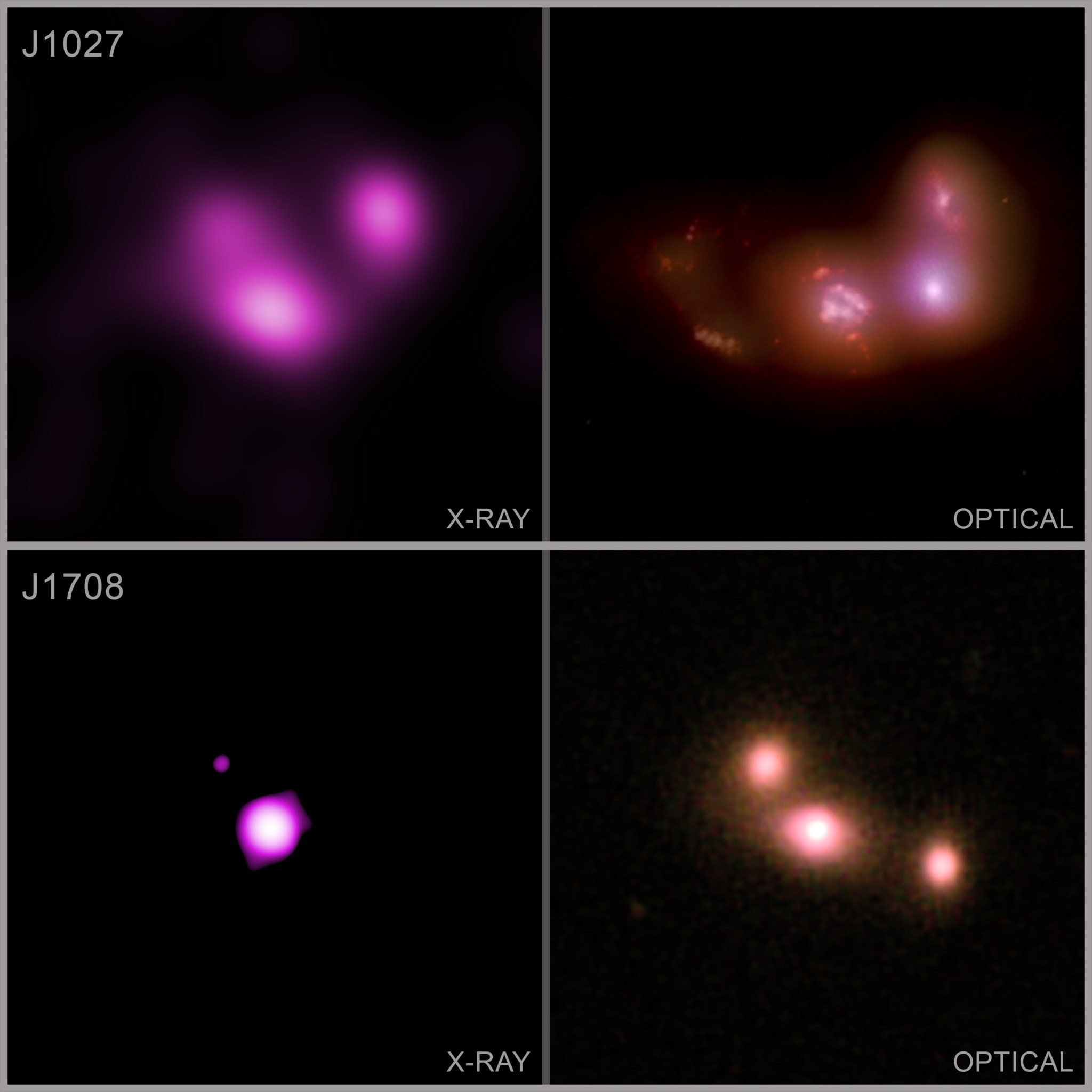
“There have been many studies of what happens to supermassive black holes when two galaxies merge,” said Adi Foord of Stanford University in California, who led the study. “Ours is one of the first to systematically look at what happens to black holes when three galaxies come together.”
She and her colleagues identified triple galaxy merger systems by cross-matching the archives – containing data that is now publicly available – of NASA’s Wide-field Infrared Survey Explorer mission and the Sloan Digital Sky Survey to the Chandra archive. They found seven triple galaxy mergers located between 370 million and one billion light-years from Earth.
Using specialized software, Foord developed for her doctorate at the University of Michigan in Ann Arbor, the team went through Chandra data, targeting these systems to detect X-ray sources marking the location of growing supermassive black holes. As material falls toward a black hole, it gets heated to millions of degrees and produces X-rays.
Chandra, with its sharp X-ray vision, is ideal for detecting growing supermassive black holes in mergers. The associated X-ray sources are challenging to detect because they are usually close together in images and are often faint. Foord’s software was developed specifically to find such sources. Data from other telescopes was used to rule out other possible origins of the X-ray emission unrelated to supermassive black holes.
The results from Foord and the team show that out of seven triple galaxy mergers, there is one with a single growing supermassive black hole, four with double growing supermassive black holes, and one that is a triple. The final triple merger they studied seems to have struck out with no X-ray emission detected from the supermassive black holes. In the systems with multiple black holes, the separations between them range between about 10,000 and 30,000 light-years.
“Why do we care about the hitting percentage of these black holes?” said co-author Jessie Runnoe of Vanderbilt University in Nashville, Tennessee. “Because these statistics can tell us more about how black holes and the galaxies they inhabit grow.”
Once they found evidence for bright X-ray sources as candidates for growing supermassive black holes in the Chandra data, the researchers incorporated archival data from other telescopes. Like a second umpire conferring about the original call, these data backed up the idea that multiple black holes were present in the merged galaxies.
To make these calls, the authors studied infrared data from the Wide-field Infrared Survey Explorer mission, the Infrared Astronomical Satellite, and the Two Micron All Sky Telescope to see how quickly stars are forming in the different galaxies in their survey. This allowed them to estimate how many of the detected X-rays are likely to come from X-ray-emitting systems containing massive stars, rather than a growing supermassive black hole. Because such star systems are young, they are more common when stars are forming more quickly. Foord and her colleagues used this technique to conclude that one of the X-ray sources they found is likely from a collection of X-ray-emitting star systems.
The Chandra and Wide-field Infrared Survey Explorer data show that the system with growing supermassive black holes has the largest amount of dust and gas. This matches theoretical computer simulations of mergers that suggest higher levels of gas near black holes are more likely to trigger rapid growth of the black holes.
The Infrared Astronomical Satellite is a joint venture of NASA and its counterparts in the Netherlands and the U.K. The Two Micron All Sky Telescope is a collaboration between the University of Massachusetts in Amherst, and NASA’s Infrared Processing and Analysis Center.
NASA’s Marshall Space Flight Center manages the Chandra program. The Smithsonian Astrophysical Observatory’s Chandra X-ray Center controls science from Cambridge, Massachusetts, and flight operations from Burlington, Massachusetts.
Read the entire feature here.
NASA Announces Role of Senior Climate Advisor
In an effort to ensure effective fulfillment of the Biden administration’s climate science objectives for NASA, the agency has established the position of senior climate advisor. Gavin Schmidt, director of NASA’s Goddard Institute for Space Science, will be in the role in an acting capacity until a permanent appointment is made.
“Climate adaptation and mitigation efforts cannot succeed without robust climate observations and research,” acting NASA Administrator Steve Jurczyk said. “With more than two dozen satellites and instruments observing key climate indicators, NASA is the premier agency in observing and understanding changes to the Earth. Furthermore, NASA enjoys broad public support and trust, lending credibility to its climate observations.”
As a representative of the agency’s strategic science objectives and accomplishments, the senior climate advisor will advocate for NASA climate investments in the context of broader government agendas and work closely with the White House Office of Science and Technology Policy and the Office of Management and Budget.
The senior climate advisor will work to:
- Promote and engage in climate-related investments in the Science Mission Directorate’s Earth Science Division.
- Promote aeronautics and other technology initiatives focused on reducing carbon dioxide emissions and broad climate impacts.
- Demonstrate and communicate the societal impacts and breadth of NASA investments related to climate.
- Foster communication and coordination within and outside the science community at NASA.
- Actively engage in amplifying the agency’s climate-related research and technological development.
Schmidt has been the Goddard Institute for Space Science director since 2014. His main research interest is the use of climate modeling to understand past, present, and future climate change, and he has authored or co-authored more than 150 research papers in peer-reviewed literature. He is a fellow of the American Geophysical Union and the American Association for the Advancement of Science. Schmidt was the inaugural winner of the American Geophysical Union’s Climate Communication Prize in 2011 and he was awarded NASA’s Outstanding Leadership Medal in 2017. He has a bachelor’s degree in mathematics from Oxford University and a doctorate in applied mathematics from University College London.
NASA’s Psyche Mission Reaches Milestone, Highlighted on ‘This Week @NASA’
NASA’s Psyche mission is featured in “This Week @NASA,” a weekly video program broadcast on NASA-TV and posted online.
Psyche is moving into the final phase of operations before its scheduled launch in August 2022. The mission will study a metal-rich asteroid orbiting the Sun in the main asteroid belt between Mars and Jupiter. It is believed this asteroid could be the heart of an early planet that lost its outer layers. Exploring the asteroid could lend valuable insight into how Earth and other planets formed.
Psyche is a project of the Science Mission Directorate’s Discovery Program, managed by NASA’s Marshall Space Flight Center.
View this and previous episodes at “This Week @NASA” on NASA’s YouTube page.
This Week in NASA History: STS-41B Lands – Feb. 11, 1984
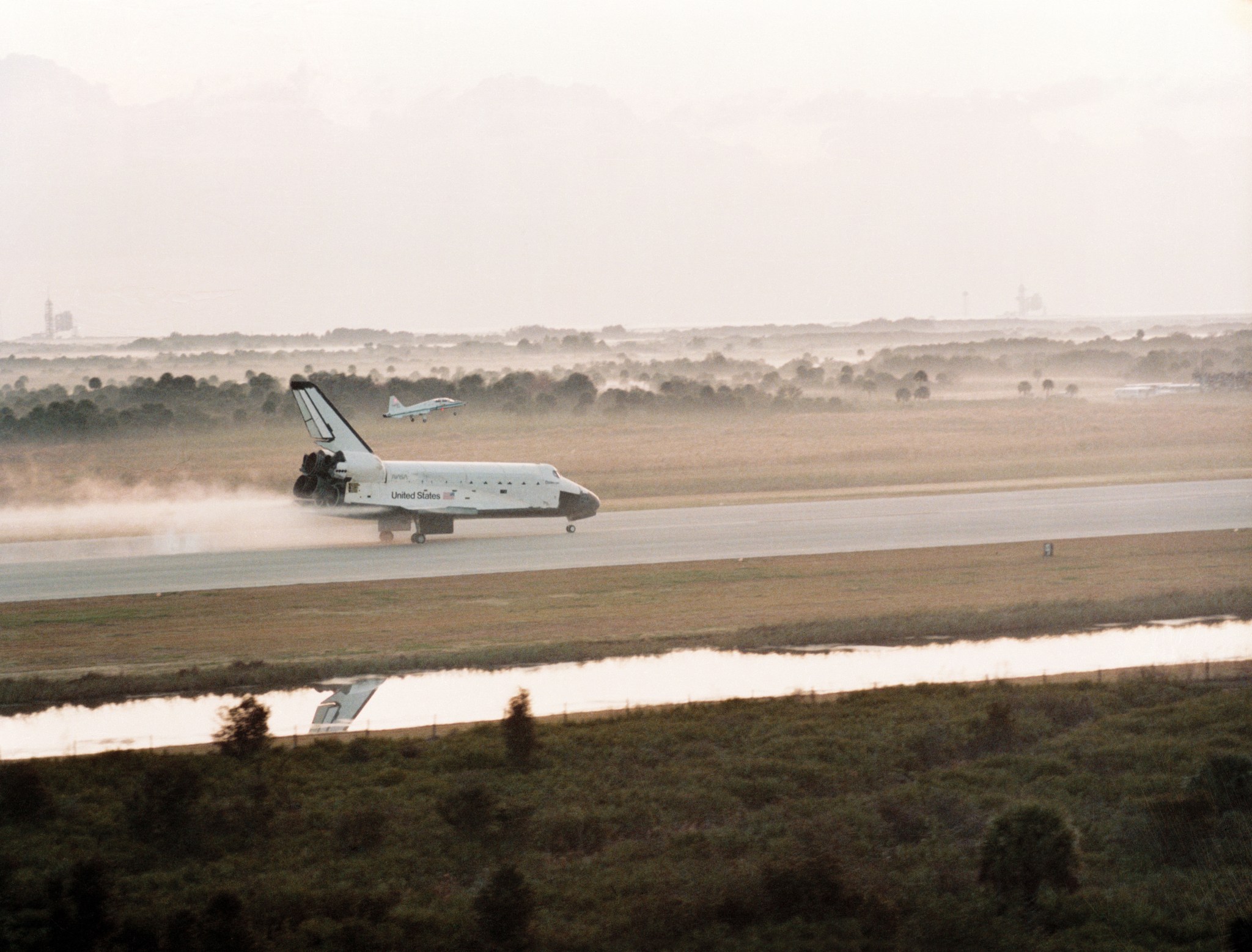
This week in 1984, space shuttle Challenger completed STS-41B, a seven-day mission that concluded with the first shuttle landing at NASA’s Kennedy Space Center. The mission launched the Westar-VI and Palapa-B2 communications satellites and featured the first untethered spacewalks, performed by astronauts Bruce McCandless and Robert Stewart using the Manned Maneuvering Unit. The NASA History Program is responsible for generating, disseminating, and preserving NASA’s remarkable history and providing a comprehensive understanding of the institutional, cultural, social, political, economic, technological, and scientific aspects of NASA’s activities in aeronautics and space. For more pictures like this one and to connect to NASA’s history, visit the Marshall History Program’s webpage. (NASA)
























